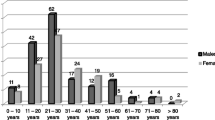Abstract
Generalized peritonitis is a common surgical emergency in India, the ‘Tropical Spectrum’ of generalized peritonitis being different from the western spectrum. A total 155 cases of generalized peritonitis were surgically treated at the All India Institute of Medical Sciences between 1981 and 1987, all patients undergoing peritoneal toilet with drainage after the cause of their peritonitis had been treated. The most common cause of peritonitis was peptic ulcer perforation, with simple closure being associated with a 2 per cent mortality, while typhoid perforation was the second most common cause. The diagnosis was clinical supported by the operative findings of a terminal ileal perforation while bacteriological, serological and histopathological confirmation was retrospective. Appendicular perforations were less common than in the west but the clinical picture was the same. Tubercular perforations were not uncommon with a previous history of subacute intestinal obstruction and evidence of tuberculosis on chest X-ray suggesting the diagnosis. Ruptured amebic liver abscess was the most common hepatobiliary cause of generalized peritonitis with drainage of the abscess producing good results. The average hospital stay was 15 days with an overall mortality of 8 per cent.
Similar content being viewed by others
References
Nomikoss IN, Katsouyanni K, Papaioannou AN. Washing with or without chloramphenicol in the treatment of peritonitis: A prospective clinical trial. Surgery 1986; 99: 20–25.
Bohnen J, Boulanger M, Meakins JL, McLean APH. Prognosis in generalized pertonitis. Arch Surg 1983; 118: 285–290.
Putzuki H, Ledwoch J, Dueben W, Mlasowsky B, Heymann H. Nontraumatic perforation of the small intestine. Am J Surg 1985; 149: 375–377.
Rajagopalan AE, Pickleman J. Free perforation of the small intestine. Ann Surg 1982; 196: 576–579.
Nair SK, Singhal VS, Kumar S. Nontraumatic intestinal perforations. Indian J Surg 1981; 43: 371–377.
Rao PVC. Experiences with emergency vagotomy and drainage procedure for perforated duodenal ulcer. Indian J Surg 1981; 43: 419–423.
Peoples JB. Candida and perforated peptic ulcers. Surgery 1986; 100: 758–764.
Christie AB. Infectious diseases: Epidemiology and clinical practice. 3rd ed. Churchill Livingstone Edinburgh 1980; 80.
Khanna AK, Misra MK. Typhoid perforation of the gut. Postgrad Med J 1984; 60: 523–525.
Vyas ID, Purohit MG, Damany SB. Operative treatment of typhoid ileal perforation with omental patch: comparative study. Br J Clin Pract 1983; 37: 367–370.
Eggleston FC, Handa AK, Verghese M. Amebic peritonitis secondary to amebic liver abscess. Surgery 1982; 91: 46–48.
Gillen P, Ryan W, Peel ALG, Devlin HB. Duodenal ulcer perforation: the effect of H2 antagonists. Ann R Coll Surg Engl 1986; 68: 240–242.
Banerji SK. Definitive surgery in duodenal ulcer perforations. Indian J Surg 1985; 47: 414–420.
Ceneviva R, Solva OC, Castel Tranchi PL, Modena JLP, Santos RF. Simple suture with or without proximal gastric vagotomy for perforated duodenal ulcer. Br J Surg 1986; 73: 427–430.
Tanphiphat C, Prayoon T, Thaland AN. Surgical treatment of perforated duodenal ulcer: a prospective trial between simple closure and definitive surgery. Br J Surg 1985; 72: 370–372.
Stringer MD, Cameron AEP. Surgeons attitude towards perforated and bleeding duodenal ulcer. Ann R Coll Surg Engl 1988 Jul; 70(4): 220–223.
Raimes SA, Devlin HB. Perforated duodenal ulcer. Br J Surg 1987; 74: 81–82.
Chauhan MK, Pande SK. Typhoid enteric perforation. Br J Surg 1982; 69: 173–175.
Eggleston FC, Santoshi B. Typhoid perforation: choice of operation. Br J Surg 1981; 68: 341–342.
Singh AB, Singh RJ. Surgical management of typhoid perforation—a new approach. J Indian Med Assoc 1987; 85(5): 140–143.
Kakar A, Aranya RC, Nair SK. Acute perforation of small intestine due to tuberculosis. Aust NZ J Surg 1983; 53: 381–383.
Author information
Authors and Affiliations
Rights and permissions
About this article
Cite this article
Sharma, L., Gupta, S., Soin, A.S. et al. Generalized peritonitis in India—The tropical spectrum. The Japanese Journal of Surgery 21, 272–277 (1991). https://doi.org/10.1007/BF02470946
Received:
Issue Date:
DOI: https://doi.org/10.1007/BF02470946



